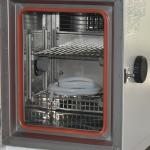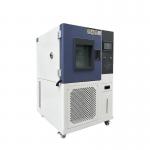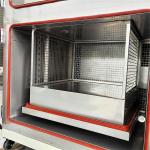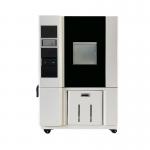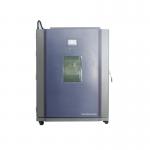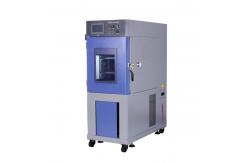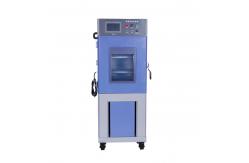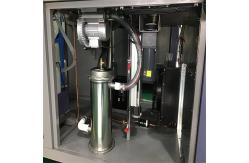In the fastidious world of laboratory research and quality control,
the Laboratory Stability Temperature Humidity Control Cabinet
Environment Test Chamber emerges as a cornerstone of accurate
experimentation and reliable results. This advanced piece of
equipment is designed to create and maintain highly controlled
environmental conditions, allowing scientists and researchers to
conduct a wide array of tests with utmost precision. The Laboratory Stability Temperature Humidity Control Cabinet
Environment Test Chamber is a specialized apparatus that offers a
stable and adjustable environment in terms of temperature and
humidity. It is an essential tool in diverse fields such as
pharmaceuticals, food science, electronics, and materials research.
By precisely regulating temperature and humidity levels, it enables
the evaluation of how samples, products, or materials respond and
change over time under specific environmental stressors. For
example, in pharmaceutical research, it helps determine the shelf
life and stability of drugs by subjecting them to different
temperature and humidity conditions that mimic real-world storage
and transportation scenarios. In electronics, it assesses the
performance and durability of components and devices in varying
environmental climates, ensuring their reliability in different
applications. - Robust and Insulated Cabinet Structure
- The test chamber is constructed with high-quality,
corrosion-resistant materials that provide durability and
longevity. The cabinet walls are made of thick, insulated panels
that effectively prevent heat transfer and maintain a stable
internal temperature. The interior surface is smooth and
non-reactive, ensuring that it does not interact with the samples
being tested. The insulation also helps in achieving precise
humidity control by minimizing condensation and moisture leakage.
- The door of the cabinet is designed with a reliable sealing
mechanism to create an airtight enclosure. It is equipped with a
heavy-duty hinge and a locking system, allowing for easy access
while maintaining the integrity of the internal environment. The
door also features a large viewing window, usually made of tempered
glass, which enables researchers to monitor the samples without
disturbing the test conditions.
- Precision Temperature and Humidity Control Systems
- The temperature control system is highly advanced and accurate. It
can maintain a wide temperature range, typically from -20°C to
+80°C, with an accuracy of ±0.3°C. The system utilizes a
combination of heating and refrigeration elements, along with a
sophisticated feedback loop and temperature sensors. It can achieve
rapid temperature changes, allowing for efficient thermal cycling
experiments. The temperature uniformity within the chamber is also
excellent, ensuring that all samples are exposed to a consistent
thermal environment.
- The humidity control system is equally precise. It can adjust the
relative humidity from 10% to 95% RH, with an accuracy of ±2% RH.
The system uses a humidifier and a dehumidifier, which are
controlled by humidity sensors and a dedicated control unit. The
humidifier may employ ultrasonic or steam-based technology, while
the dehumidifier can use condensation or desiccant methods. This
allows for the creation of a wide variety of humidity conditions,
simulating everything from arid to highly humid environments.
- Advanced Instrumentation and Data Acquisition
- The chamber is equipped with a suite of high-quality sensors.
Temperature sensors are strategically placed throughout the
interior to monitor any temperature gradients and ensure uniform
temperature distribution. Humidity sensors provide real-time data
on the relative humidity levels. These sensors are connected to a
state-of-the-art data acquisition system that records and stores
all the measured parameters. The data can be accessed and analyzed
in real-time or retrieved later for in-depth studies.
- The control panel of the chamber is user-friendly and intuitive. It
allows researchers to easily set the desired temperature and
humidity levels, as well as program complex test sequences. The
panel displays all the relevant information, including current
temperature, humidity, and the status of the control systems. It
also has built-in alarms and safety features to alert operators in
case of any abnormal conditions or system failures.
- Temperature Range: As mentioned, the chamber can operate from -20°C to +80°C. This
range is suitable for testing a vast array of samples. For
instance, in food science, it can be used to study the spoilage
rate of perishable foods at different temperatures, while in
electronics, it can evaluate the performance of components under
both cold and hot conditions.
- Humidity Range: The relative humidity can be adjusted from 10% to 95% RH. In some
applications, such as the storage of hygroscopic materials or the
testing of moisture-sensitive products, specific humidity levels
need to be maintained. For example, in the pharmaceutical industry,
certain drugs may require a particular humidity range to ensure
their stability and potency.
- Uniformity and Stability: The temperature uniformity within the chamber is maintained
within ±0.5°C, ensuring that all samples experience a consistent
thermal environment. The humidity uniformity is within ±3% RH,
providing reliable and reproducible testing conditions. The
stability of both temperature and humidity is excellent, with
minimal fluctuations over time, allowing for accurate and long-term
testing.
- Accurate Environmental Simulation
- The primary function of the test chamber is to accurately simulate
different temperature and humidity environments. By precisely
controlling these parameters, it allows researchers to evaluate how
samples will behave in various real-world scenarios. This helps in
optimizing product designs, selecting appropriate materials, and
improving manufacturing processes. For example, in the development
of new packaging materials, the chamber can be used to test how
they protect the contents under different temperature and humidity
conditions, leading to the creation of more effective packaging
solutions.
- The ability to create complex environmental profiles, such as
cyclic temperature and humidity changes, is also a valuable
function. This can help in identifying potential weaknesses or
failure points in samples that may not be apparent under static
conditions. For instance, in the automotive industry, components
can be tested under cyclic temperature and humidity conditions to
simulate the changes they experience during different seasons and
driving conditions.
- Compliance with Industry Standards and Regulations
- Many industries have strict standards and regulations regarding
product testing in specific environmental conditions. The
Laboratory Stability Temperature Humidity Control Cabinet
Environment Test Chamber is a reliable tool for ensuring
compliance. For example, in the pharmaceutical industry, products
need to meet certain temperature and humidity requirements to
ensure their safety and efficacy. By using this chamber to conduct
tests in accordance with relevant standards like ICH, USP, or GMP,
manufacturers can prove that their products meet the necessary
criteria, facilitating market access and enhancing consumer
confidence.
- Regulatory bodies rely on accurate test results obtained from such
chambers to enforce safety and quality regulations. It serves as a
dependable means for inspectors and certifying agencies to
determine the suitability of products for use in different
applications.
- Research and Development Support
- In the field of research and development, this chamber is an
invaluable asset. It allows scientists and engineers to conduct
fundamental studies on the effects of temperature and humidity on
new materials and technologies. For example, in the development of
new polymers, the chamber can be used to evaluate how different
temperature and humidity conditions affect their mechanical,
chemical, and physical properties. This data can then be used to
optimize the material formulations and processing techniques.
- The detailed data provided by the test chamber serves as a roadmap
for innovation. It enables researchers to explore new design
concepts and materials that can better withstand environmental
stress, leading to the development of more advanced and reliable
products.
- Stringent Manufacturing Process
- The Laboratory Stability Temperature Humidity Control Cabinet
Environment Test Chamber is manufactured under strict quality
control procedures. Each component, from the insulation panels to
the temperature and humidity control systems, is carefully sourced
and inspected for quality and performance. The assembly process is
carried out by highly trained technicians in a clean and controlled
environment, ensuring the proper alignment and functionality of all
parts.
- The calibration of the temperature and humidity sensors and control
systems is a critical and regular part of the manufacturing
process. It is performed using traceable reference standards to
guarantee the accuracy and reproducibility of the test results.
Rigorous quality audits and inspections are conducted at various
stages of production to maintain the highest level of product
quality.
- Quality Certification and Validation
Our chamber has obtained relevant quality certifications and has
been validated by independent testing laboratories. It has been
proven to provide accurate and reliable test results, conforming to
the relevant international and national standards. We also
continuously update and improve our product based on the latest
technological advancements and customer feedback to ensure its
long-term performance and compliance.
|
